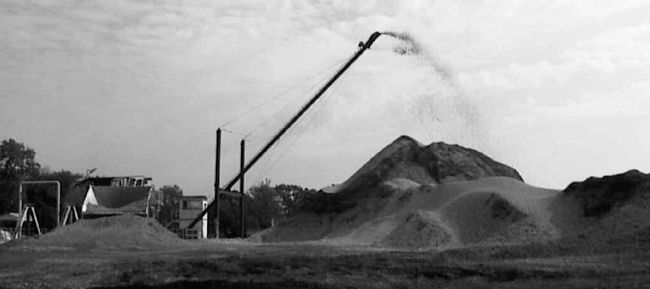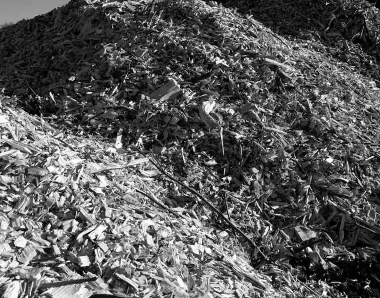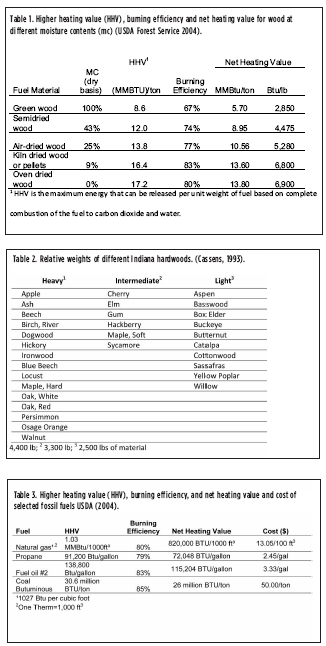
Spring 2009
Volume 18 No. 1
Our Current Energy Dilemma: Part 1
Wood as a Fuel Source
By Ed Meadows, Daniel Cassens and Klein Ileleji

Many of us have always used the forest as a source of energy and will continue to do so. Before being labeled woody biomass, the most common form is called firewood! Energy from wood, namely heat conversion, is a well established and time tested technology. We know how to harvest, transport, and process or burn wood in any of its many forms. With a lot of interest in producing fuels and energy from renewable feedstocks, we should now be asking if wood manufacturing residues (wood wastes) and especially our existing forest lands can provide a source of industrial energy for electrical generation, industrial plants with process steam requirements, wood pellet production, or eventually as feedstock for the production of liquid fuels. The impact of more intensive harvesting on the site, wildlife and flora components of the forest also need to be investigated.
BTU Value of Wood
Before looking at the volumes and availability of this source of woody biomass and its potential contribution to our energy supply, an understanding of wood as a fuel source will be useful. First, an oven dry pound of hardwood biomass has a heat content of about 8,600 British Thermal Units (BTU) (Bowyer it.el.2003). Koch (1985) reports that hardwoods have a heat content of 7,800 BTU per oven dry pound. There is some variation from species to species, and between wood, bark and branches, but these small differences are usually not considered in commercial applications. Softwoods such as pine, spruce, and fir, will have a somewhat higher BTU rating due to the presence of resin.
A BTU is simply the amount of energy required to raise one pound of water one degree Fahrenheit. For comparison, a densified liquid fuel such as gasoline has a heat content of 114,000 BTU per gallon when burned, so roughly, on a BTU comparison, a ton of oven-dry wood is equivalent to fifteen gallons of gasoline. This is a theoretical consideration.
The moisture content of the wood and the burning efficiencies in conversion to usable heat (BTUs) must be considered in comparing to any fuel. And BTU variation in wood, primarily due to moisture content, is substantial. Moisture content is the water present in wood. It is the highest when wood is freshly cut and as processed called “green” before the wood is dried. Green hardwoods contain about one-half of their weight as water on an oven-dry basis. Ash is one of the lowest with a heartwood moisture content of about only 46 percent and a sapwood moisture content of 44 percent. Yellow poplar is one of the highest with heartwood at 83 percent, and the sapwood at 106 percent moisture content. Green, red, and white oak contain about 60 to 80 percent moisture. Given sufficient time and conditions, well air dried wood will have a 15 to 20 percent moisture content.
Moisture content is an important consideration when converting wood to heat energy by way of combustion. Energy has to be expended to evaporate the moisture. Of the potential BTU’s contained in a pound of green wood, about one-half are used to heat the water in the wood and exhaust it from a boiler system or stove.
Furthermore, since boilers are not 100 percent efficient in transferring all the usable heat content, more BTU’s are lost in the burning process; tables 1 & 3 list typical conversion efficiencies. To burn one pound of air dried wood containing 6,900 BTU’s, about 1,620 BTU’s are used in the combustion process and exhausting the flue gases; that leaves 5,280 BTU’s available. If the fuel is green, or one-half water and one-half dry wood, only 2,850 BTU’s are available per green pound. That is also the technical explanation of why you dry firewood.

Since the moisture content of wood is variable and critical to
its fuel value, the net heating value of wood also varies (Table 1). Note the
conversion efficiencies for combustion decreases as the fuel moisture content
increases. An efficiency value of 77% means only 77% of the usable heat is
transferred for use. Thus, 23% is not captured and exhausts out the chimney or
stack. Net heating is the usable, transferred heat (BTU) taking into
consideration moisture content and efficiency.
Higher heating values or HHV are the theoretical BTU before combustion and efficiency losses of a particular fuel. For home heating, wood is normally sold by the cord or rick, yet there are other units of measure to deal with. A cord is a volume of material four feet by four feet by eight feet (128 cubic feet) or its equivalent. A rick is only defined as four feet high by eight feet stack length, piece length not given. At a 16-inch piece length, it takes three ricks to equal a cord.
Lighter weight woods still have some heat content per pound, however, more volume (weight of wood) is required to equate to the heavy wood species. A cord or 128 cubic feet of wood, bark, and air spaces of air dried, heavy hardwoods, will weigh about 4,400 pounds; medium weight woods 3,300 pounds; and light weight woods 2,500 pounds. Table 2 lists different wood species by these three categories.
BTU Value of Fossil Fuels Like wood, each fuel type has its own BTU value and burning efficiency (Table 3). Burning efficiencies vary but the numbers provided in Table 3 are commonly reported. Depending on the fuel type, higher efficiency equipment may be available at an elevated purchase price.
With this information, the value of wood at a selected moisture content for fuel in comparison to other fuels, can be estimated. For example, 1,000 cubic feet of natural gas or a “therm” at 80 percent burning efficiency will produce 820,000 BTU’s (Table 3). One ton of air dried wood at 77 percent burning efficiency will produce 10.56 million BTU’s (Table 1). It will require 12.88 therms of natural gas to supply the same amount of BTU’s as one ton of air dried wood (10.56 million / 820,000). A cord of heavy air dried wood (Table 2) will weigh 4,400 pounds or 2.2 tons. So, on a BTU basis, the cord is equivalent to 28.34 therms (12.88 x 2.2). At $13.00 per therm for residential costs, the comparative value of the cord of wood becomes $368.42. Many readers may not realize natural gas has doubled in price over the last ten years.
A comparable analysis for electricity starting with a cord of heavy air dried hardwood is as follows. The cord of wood has 23.23 million BTU’s (10.56 x 2.2) of energy. A kilowatt hour of electricity will produce 3,400 BTU’s. Therefore, the cord of wood on a BTU basis is equal to about 6,832 KWH (23.23 million / 3,400). At $.08 per KWH the value of the cord of wood is $546.56. Most homes in cold winter regions for this reason don’t use electric resistance heat. For years homes have used “low cost” fossil fuels or natural gas. However, a ton of high quality coal at 85 percent burning efficiency will produce about 26 million BTU’s and one cord of heavy hardwoods produces 23 million BTU’s. So, it will take 1.12 cords to equal the ton of coal. If Indiana coal is priced at about $50.00 per ton, the value of the cord of wood becomes $44.64 on a BTU equivalent basis.
Editorial Note: Part II in this series, “Wood Energy Potential from Closure of Terre Haute Paper Mill,” will be published in the next issue of the Woodland Steward. Ed Meadows, recently completed a M.S. degree at Purdue University in Wood Products, with a special focus on the utilization of the Forest Products supply chain residues (processing and harvest) for bioenergy. Ed provides timber marketing and wood energy related consulting services. Daniel Cassens is a professor of wood products at Purdue University’s Department of Forestry and Natural Resources. Klein Ileleji is a Professor and Extension Engineer in the Agricultural and Biological Engineering Department at Purdue University. One area of expertise is biomass collection and transportation to support bioenergy.
References: Bowyer, Jim L., Rubin Schmulsky and John G. Haygreen. 2003. Forest Products and Wood Science, An Introduction, 4th Ed., Iowa State Press. 554 pp. Cassens, D. 1993. Wood for home heating. Cooperative Extension Service Publication FNR-79, Purdue University, Publications Mailing Room, 301 S. 2nd Street, Lafayette, IN 8pp. Koch, Peter. 1985. Utilization of hardwoods Growing a Southern Pine Sites. Vol. 1 of 3, Agr. Handbook, No. 605. USDA Forest Service. 1418 pp. USDA Forest Service. 2004. Fuel value calculator. Techline Series. Madison, Wisconsin: USDA Forest Service, Forest Products Lab., State and Private Forestry Technology Marketing Unit. Retrieved December 2007 from http://www.fpl.fs.fed.us/documnts/techline/fuel-value-calculator.pdf.